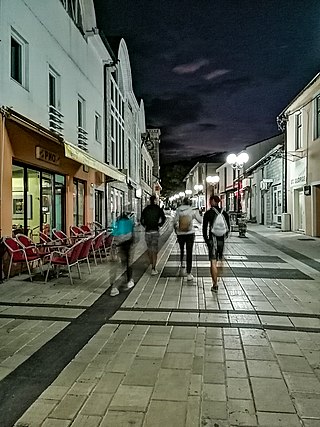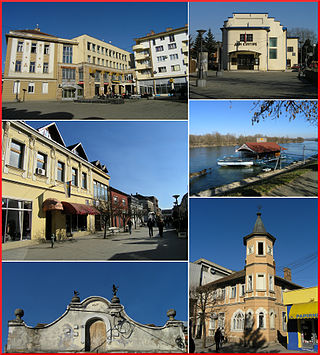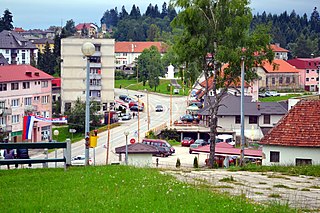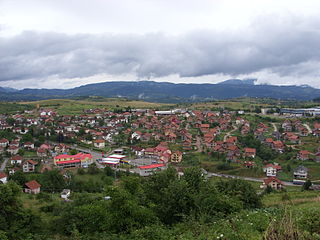
Srebrenica is a town and municipality in Republika Srpska, Bosnia and Herzegovina. It is a small mountain town, with its main industry being salt mining and a nearby spa.

Republika Srpska is one of the two entities of Bosnia and Herzegovina, the other being the Federation of Bosnia and Herzegovina. It is located in the north and east of the country. Its largest city and administrative centre is Banja Luka, lying on the Vrbas river, and with a population of about 138,963 people.
Kravica is a village in Bratunac, Republika Srpska, Bosnia and Herzegovina. As of 2013 census, it has a population of 567 inhabitants.

Foča is a town and municipality in Republika Srpska, Bosnia and Herzegovina. It is located in south-eastern Bosnia and Herzegovina, on the banks of the Drina river. As of 2013, the town has a population of 12,234 inhabitants, while the municipality has 18,288 inhabitants. Foča houses some faculties from the Istočno Sarajevo University. It is also home to the "Seminary of Saint Peter of Sarajevo and Dabar-Bosna", one of seven seminaries in the Serbian Orthodox Church. Foča was also, until 1992, home to one of Bosnia's most important Islamic high schools, the Madrasa of Mehmed Pasha Kukavica. The Sutjeska National Park, which is the oldest National Park in Bosnia and Herzegovina, is located in the municipality.

Bijeljina is a city and municipality in Republika Srpska, Bosnia and Herzegovina. It is the provincial center of Semberija, a geographic region in the country's northeast. As of 2013, it has a population of 107,715 inhabitants.

Šamac, formerly Bosanski Šamac is a town and municipality in Republika Srpska, Bosnia and Herzegovina. There are also small, uninhabited, parts located in the municipalities of Odžak and Domaljevac-Šamac, Federation of Bosnia and Herzegovina.

Gradiška, formerly Bosanska Gradiška, is a city in Republika Srpska, Bosnia and Herzegovina. As of 2013, it has a population of 51,727 inhabitants, while the city of Gradiška has a population of 14,368 inhabitants.

Nevesinje is a town and municipality in Republika Srpska, Bosnia and Herzegovina. As of 2013, the town has a population of 5,162 inhabitants, while the municipality has 12,961 inhabitants.

Novi Grad, formerly Bosanski Novi, is a town and municipality in Republika Srpska, Bosnia and Herzegovina. Situated in the far northwest of the country, it lies across the Una from the Croatian town of Dvor. According to the 2013 census, the town has a population of 11,063 while its municipality comprises a total of 27,115 inhabitants.

Kozarska Dubica, formerly Bosanska Dubica is a town and municipality in Republika Srpska, Bosnia and Herzegovina. As of 2013, it has a population of 21,542 inhabitants, while the town of Kozarska Dubica has a population of 11,566 inhabitants.

This article is about the Demographic history of Bosnia and Herzegovina, and deals with the country's documented demographics over time. For an overview of the various ethnic groups and their historical development, see Ethnic groups in Bosnia and Herzegovina.

Gacko is a town and municipality in Republika Srpska, Bosnia and Herzegovina. It is situated in the region of East Herzegovina. As of 2013, the town has a population of 5,784 inhabitants, while the municipality has 8,990 inhabitants.

Trnovo is a municipality of the city of Istočno Sarajevo, Republika Srpska, Bosnia and Herzegovina.

Han Pijesak is a town and municipality in Republika Srpska, Bosnia and Herzegovina. As of 2013, it has a population of 3,530 inhabitants, while the town of Han Pijesak has a population of 2,018 inhabitants.

Kostajnica, formerly Bosanska Kostajnica, is a town and municipality located in Republika Srpska, Bosnia and Herzegovina. It is situated in the part of the Кrajina region. As of 2013, it had a population of 5,977 inhabitants, while the town of Kostajnica has a population of 4,047 inhabitants.

Ljubinje is a town and municipality in Republika Srpska, Bosnia and Herzegovina. It is situated in south-eastern part of Herzegovina. As of 2013, the town has a population of 2,744 inhabitants, while the municipality has 3,511 inhabitants.

Prnjavor is a town and municipality in Republika Srpska, Bosnia and Herzegovina. According to the 2013 census, the town has a population of 8,120 inhabitants, with 35,956 inhabitants in the municipality.

Vlasenica is a town and municipality in Republika Srpska, Bosnia and Herzegovina. As of 2013, it has a population 11,467 inhabitants, while the town of Vlasenica has a population of 7,228 inhabitants.

Šekovići is a town and municipality in Republika Srpska, Bosnia and Herzegovina. As of 2013, it has a population of 6,761 inhabitants, while the town of Šekovići has a population of 1,519 inhabitants.
The Kravica attack was an attack on the Bosnian Serb village of Kravica by the Army of the Republic of Bosnia and Herzegovina (ARBiH) from the Srebrenica enclave on Orthodox Christmas Day, 7 January 1993. The attack was organized to coincide with the Serbian Orthodox Christmas, leaving the Serbs unprepared for any attack. 43-46 people died in the attack on the Serb side: 30-35 soldiers and 11-13 civilians.
























